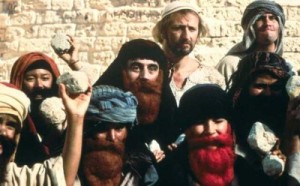The 20th and 21st century has been marked by a rise in religious fundamentalism. It is as if that faced with technology and economic change, the established religions have returned to the comfort of a literal interpretation of their creeds. The first moves towards religious fundamentalism were started by the Christians in the late 19th century and were copied by the Muslims in the early 20th. (one of the best books to read on the subject its Robert Gilbert’s Cast the First Stone).
Essentially fundamentalism claims that there is an absolute truth to be discovered within the texts of a religious faith. Often these texts are selected by a panel of other fundamentalists. Christians fundamentalists are often influenced by verses calling for the death of gay people but ignore other verses in the Bible which are equally as daft. They also believe that the world was created in seven days and is only 6,000 years old on the mistaken belief that the Bible says that. Muslim fundamentalists call for the lowering of status of women, not because the Koran says that, but because the tribal traditions think so.
The payoff for fundamentalism is certainty. You know where you are with your religion because it is written down and you can’t fuck it up. However, it does not favour anyone who thinks, or asks questions.
But this desire to find certainty in an uncertain world contaminates the development of any magical tradition. Wicca, which is more of a religion anyway, has a fundamentalist streak of people who insist that the “burning times” were a fact and that millions of witches were burnt at the stake.
The same applies to the Golden Dawn.
Within the Golden Dawn, you will find those who search for old papers, which are often above their grade anyway, and quote them as an authority for whatever they want to mean. The assumption is that Mathers and Westcott were inspired by god to write the various documents they did with a Biblical authority.
Yet there are some problems with this. It assumes that the Golden Dawn sprang fully formed in 1888 and that there ever was a true paper. The Golden Dawn started out as a re-write of a skeletonic manuscript called the Ciphers. This envisaged a five-degree system based on the elements and dealing with the lower part of the tree of life. The ciphers hinted at a 5=6. Mathers banged out a quasi-masonic system, which admitted women, and the whole thing was entirely unmagical. It appeared to have more in common with the SRIA of its day in that there was an opening and closing, testing of knowledge and people provided papers.
However it was clear that this was not enough and Mathers then wrote a portal ritual to go with it, however again this was not a magical ritual. A true Golden Dawn fundamentalist who believes that the Cipher documents were the trigger point of the Order would have to say that anything beyond the 4=7 was a heresy. He or she would have to say that Mathers was possessed by an evil force when he attempted to add other grades and bring in MAGIC. And if you think this idea is weird it is something I have heard some people actually say!
It was not until Mathers went to Paris that the magical side of the Golden Dawn was created. Not only was there a vault and a 5=6 ritual the outer order papers were retrofitted with magical instructions called the Z documents.
Theoretically, this would be the high point of the Golden Dawn if you wanted a magical system. If you were going to be a fundamentalist, you would say that these were “perfect.” You would be wrong.
Mathers had not finished writing what would be seen as key Golden Dawn documents until much later. He finished the ThAM papers only a few months before the schism and much of the material you would accept as Golden Dawn came from these papers. If you were to take *this* was the high point for the Golden Dawn Magic System you would fail again.
After the schism, the portal was rewritten by a person, or persons unknown. It turned the god-awful portal ritual into something which magically fitted better as a pivot for the outer and inner order. True this ritual was a little clunky, but it was much better than what went before it. Until I printed Mathers Last Secret, the earlier ritual was mostly unknown, indeed most considered the later ritual as the GD canon.
Secondly, the Second Order of the Golden Dawn stopped at ThAM with no more rituals or teaching. Mathers’ AO and Felkin’s Stella Matutina carried on these grades and fleshed out the some of the earlier teachings.
In essence, the Golden Dawn never had a fundamentalist point in which it was complete and could be used as a complete system. Nor was it possible to point to written cannon of work which was finished. Papers within the GD were rewritten over time so an earlier paper might be merged into another one, rewritten completely, or abandoned completely. Imagine what this would be like for a fundamentalist Christian if a panel of priests did something similar to the book of Revelation.
Some have attempted to enforce a degree of fundamentalism within the GD by saying that the “black book” of Israel Regardie (minus the worthless introduction) should be seen as the Bible of the Golden Dawn and straying from that would be heresy. As Pat Zalewski pointed out in his books, Regardie’s cut down rituals break important parts of the Golden Dawn magical system so using that as your “bible” was unadvisable.
The issue here is that the Golden Dawn as a magical system is evolving. Because something was written down does not mean that it was perfect or “right.” It was just based on the information that Mathers and others had at the time.
When the Magical Order of the Aurora Aurea withdraw from the Golden Dawn egregore one of the reasons was to separate itself from those who insisted that we limit ourselves to their fundamentalist ravings. What might give them certainty and comfort, is actually anti-magic and anti-magical development.
Take for example the 5=6. Most people in the Golden Dawn see the 5=6 ritual as the finest thing that Mathers came up with. With its vault, the 5=6 is a truly impressive ritual. When I had to pull apart the 5=6 for MOAA so that I could understand it from a magical perspective, I found next to nothing written about it. What I had to do is gather people’s responses to key parts in the ritual. In the end I had to point someone through the rite and see what happened.
The result was interesting. The ritual worked well and made sense right up to the symbolic death of the candidate. Then it got silly. There were symbols there which were simply wrong, or described in the wrong way and in the wrong place. Most of the problems could be fixed with an edit or a slight change of technique, but that could not cover the one significant howler.
SPOILER ALERT
The candidate has symbolically died and they are led into the tomb to meet their Higher Self in the form of Christian Rosenkreuz. He finds him dead. He touches his dead body and the corpse speaks, but remains dead. There is no resurrection in the grade. The candidates lower self is sacrificed and pushed down to the Qlippoth but never has a meaningful awakening with its higher. Lately several modern Golden Dawn people have started to see the problems here and started to tinker with this part of the ritual to make it work properly.
So is there any advantage in being a Golden Dawn fundamentalist? Only if you are a bit dim and like an imagined certainty. But if you want to be a magician you have to accept that every piece of paper you read in the GD is a suggestion for an experiment, rather than meant to be carved on stone. If you want certainty you should really give up being a Magician because it is all evolving and all changing.





Comments are closed